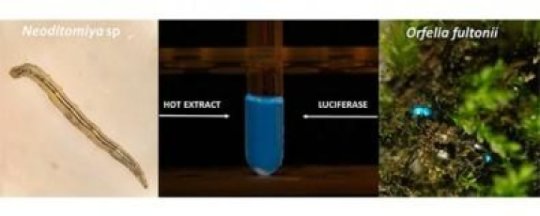[ad_1]
An insect larva found in the caves of Intervales State Park, an Atlantic Rainforest remnant in the municipality of Ribeirão Grande, São Paulo State, Brazil, was initially of no interest to the research group led by biochemist Vadim Viviani, a professor at the Federal University of São Carlos (UFSCar) in Sorocaba. The researchers are investigating bioluminescence, the capacity of living organisms to produce their own light.
Nevertheless, the larva of Neoditomyia, a genus of non-luminescent cave worms, proved to be a promising object of study. Although it does not emit light similar to that of other insects of the family Keroplatidae (fungus gnats) in the order Diptera (true flies), this insect produces luciferin, a molecule indispensable for the bioluminescent members of the family.
The discovery is the first of its kind in the Neotropics and has just been published in the journal Photochemical & Photobiological Sciences.
The other 15 species of Keroplatidae that produce luciferin are found in the Appalachian Mountains (USA, one species), New Zealand (eight), Australia (one) and Eurasia (five). All are bioluminescent.
“If what we found here produces luciferin without emitting light, it’s possible that the molecule has another biochemical function of which we’re unaware,” Viviani told.
The cave worm larva found in the Atlantic Rainforest biome does not emit light because its luciferin is only one of the components required to do so. Luciferin is a small molecule that emits light when oxidized (exposed to oxygen). For luciferin to be oxidized and emit light, however, an animal must also produce luciferase, an enzyme that catalyzes the bioluminescent reaction.
This keroplatid’s cousins in the northern hemisphere and Oceania produce both molecules and therefore emit light, as do fireflies, glow-worms, and other insects.
The molecular structures of luciferin and luciferase in dipterans and fireflies are completely different and do not react with each other to emit light. Only luciferin and luciferase produced by the same organism can react to emit light.
To determine whether the substance found in the cave worm larva was indeed luciferin, the researchers mixed it with purified luciferase from Orfelia fultonii, the keroplatid species from the Appalachians. To their surprise, the mixture emitted blue light similar to the light emitted by O. fultonii.
Enzymes similar to beetle luciferase have been found in non-luminescent species, but the occurrence of luciferin in terrestrial organisms has so far been limited to luminescent species. Hence, the novelty of this discovery.
In addition to Viviani, the co-authors of the study included postdoctoral researcher Danilo Trabuco do Amaral, and doctoral researcher Vanessa Rezende Bevilaqua, both affiliated with UFSCar and recipients of scholarships from São Paulo Research Foundation — FAPESP, as well as postdoctoral researcher Rafaela Falaschi, who is affiliated with the University of Ponta Grossa. The study was part of the Thematic Project “Arthropod bioluminescence,” which is funded by FAPESP.
Laboratory use
In addition to captivating people who find bioluminescent species at night, the light-emitting substances they produce are widely used for research in medicine, biotechnology, manufacturing, and pharmaceuticals. Genetic engineering to mark specific cells with bioluminescent substances allows them to be easily observed under a microscope, for example.
“Bioluminescent substances are used to mark cancer cells, test sperm viability, and detect pathogens and even heavy metals in water samples,” said Viviani, who chairs the International Society for Bioluminescence & Chemiluminescence (ISBC).
Once it has been fully characterized, the new luciferin may also be used in analytical applications, including as an indicator of specific cells. “We don’t yet know all its potential applications, but its chemical composition has peculiarities that could lead to many other uses,” Viviani said.
Biotechnology applications of the luciferin-luciferase combination that produces blue light, he recalls, differ from applications of the more energetic luciferin-luciferase reaction that produces yellow-green light in fireflies and glow-worms.
Recent evolution
The authors of the study also tested the larvae of two other dipterans to search for luciferin that interacted with luciferase from O. fultonii.
Arachnocampa luminosa, the New Zealand glow-worm, emits light to lure prey to its cave webs, but laboratory tests showed the bioluminescence of this species to be different because it did not emit light when brought into contact with the Appalachian species.
The same results were observed with Aedes aegypti, demonstrating that the mosquito that transmits dengue, chikungunya, Zika, and yellow fever does not have molecules similar to luciferin, or if it does, they do not interact with the tested luciferase.
Nevertheless, the study contributes to the search for bioluminescent substances in other species. The occurrence of luciferin in a non-luminescent larva may indicate that it has a different but equally important biological function in keroplatids. This finding suggests that bioluminescence is a trait that has evolved more recently in insects that already produced luciferin for other biological purposes.
The researchers do not rule out the possibility of applying knowledge of luciferin and luciferase in bioluminescent insects to the control of disease-bearing mosquitos because these molecules are ideal to mark cells and investigate intracellular processes.
“If dipteran luciferin and related compounds do indeed prove to play an important role in the physiology of the organism, we might be able to interfere with mosquito reproduction,” Viviani said.
The next stage of the project involves determining the chemical structure of the novel luciferin. Viviani plans to conduct it in collaboration with Cassius Stevani, a professor at the University of São Paulo’s Chemistry Institute (IQ-USP), and colleagues at other partner institutions.
[ad_2]















